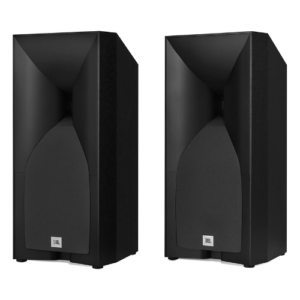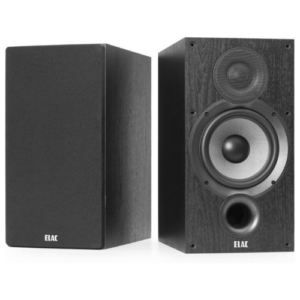The JBL Studio 530 and the ELAC Debut 2.0 B6.2 are good speakers in a crowded price bracket for bookshelf speakers. Both are often priced similarly and belong in the conversation for best bookshelf speakers under $500. We’ll discuss what both bring to the table and review how they differ. We’ll start off with some key specifications.
Key Specifications
Type: Passive
Power: 25-125W (suggested)
Frequency Response: 45~40,000Hz
Sensitivity: 86 dB
Impedance: 6 Ohms
Drivers: 2 – 5.25″ Low-Frequency Woofer and 1″ High-Frequency Compression Driver
Connectivity: Speaker Wire
Weight: 17 lbs. each
Dimensions: 8.4″W x 18.4″H x 8.5″D
Type: Passive
Power: 120W (Max)
Frequency Response: 44~35,000Hz
Sensitivity: 87 dB
Impedance: 6 Ohms
Drivers: 2 – 6.5″ Aramid Fiber Woofer and 1″ Soft Dome Tweeter
Connectivity: Speaker Wire
Weight: 16.3 lbs. each
Dimensions: 7.8″W x 14.8″H x 11.3″D
Comparison: JBL Studio 530 vs ELAC Debut 2.0 B6.2
Power Handling and Volume
The JBL Studio 530 bookshelf speakers are very similar to the ELAC Debut 2.0 in regard to their power specifications. Both pairs of bookshelf speakers are 6 Ohms. The JBL 530s have a sensitivity of 86 dB. The ELAC Debut 2.0 B6.2 has a sensitivity of 87 dB. Remember to take this into account if you want sound that fills a large room. Make sure you pair them with an amplifier or AVR that has sufficient power.
An amplifier will be needed to drive both of these as they are passive bookshelf speakers. ELAC lists the B6.2 speaker as having a max power input of 120 Watts. The JBL 530s have a suggested wattage of 25-125 Watts. Both of the wattage ratings are for each channel. Most amps and receivers will be capable of powering these speakers. Those with larger rooms and high volume requirements should plan for an amplifier or AVR with more juice.
Construction and Size
The JBL Studio 530s (8.4″W x 18.4″H x 8.5″ D) are slightly larger than the ELAC speakers. The JBL Studio 530 bookshelf speakers have a bold and domineering design. You’ll hear the design often referred to as divisive in reviews. I initially came down on the side of not being a fan of this design. I’m one to describe the aesthetic of some speakers in glowing terms. It’s not something I would do for the JBL 530. I will admit the design is less offensive in person. They have a striking, unique quality. Some will like the design. Others will like something more traditional. At 17 pounds, the JBL 530s also have some heft to them. The well-built MDF wood construction gives them the feel of a tough and sturdy speaker. You’ll find a bass port on the back of the speakers along with the dual, gold-plated binding post. The binding post on this speaker is bi-amp capable.
You’ll find a much more minimal and traditional design on the ELAC Debut 2.0 B6. 2. Its understated black design will blend well with modest setups. It should definitely be your pick if you’re dealing with the WAF (wife acceptance factor). They measure 7.8″W x 14.8″H x 11.3″D and weigh roughly 16 pounds. Once again, they aren’t the smallest bookshelf speakers. This is mostly due to the larger 6.5″ woofer. That’s about the ceiling size-wise for a driver on bookshelf speakers. ELAC makes a more compact version of these speakers with smaller drivers. Unlike the JBL speakers, the bass port sits on the front of the ELAC Debut 2.0 B6.2. This should allow for slightly more flexible speaker placement. The binding post on the rear of the speaker won’t allow you to bi-amp.
Sound Quality and Configuration
Both of these speakers have 1″ tweeters. The ELAC Debut 2.0 B6.2 has a soft dome tweeter. The JBL has a 1″ high-frequency compression tweeter. The tweeter on the JBL 530 bookshelf speakers is also loaded in a large bi-radial horn. You’ll find a slightly larger 6.5″ aramid fiber woofer on the ELAC B6.2. That’s compared to the 5.25″ woofer to hand low and mid-range frequencies on the JBL Studio 530. The frequency response on the JBL 530 bookshelf speakers is 45 to 40,000Hz. That’s slightly wider than the 44 to 35,000Hz range on the ELAC B6.2.
Bookshelf speaker comparisons can be difficult. It’s not hard to find good speakers that sound great. Deciding which sound is good for your use case can be a struggle. Certain characteristics can help you decide which speaker is better for you though. Some people prefer bigger bass and others prefer a speaker with a flat EQ response.
The sound signatures on these speakers are different enough to assist in this comparison. The JBL 530s are great speakers heavily colored by their bi-radial horn. Detail and imagery are really great on the JBL 530. Audio from these speakers has good clarity. I never felt like any frequencies were overemphasized even if they are slightly bright. These speakers have a very impressive soundstage. They performed extremely well in my home theater set-up. When disabling my center channel, dialog still projected very well. The JBL 530s would perform very well in a phantom center setup. I tested them slightly toed-in and was surprised by how well wide the soundstage sounded. The JBL 530s have a magical quality in that regard. The 530s are also part of the JBL Studio Series which includes more speakers. That’s perfect if you want to expand to a larger speaker system with a center channel and tower speakers.
The midrange and vocals are smooth, but the treble is where these speakers shine. The JBL 530s are a pair of speakers that have a lively quality to them. They sound good for movies and music. Bass response on the JBL 530 is tight and fun even if it’s not very impactful. It’s still more bass than I would expect from a woofer this size. You would need a subwoofer to pair with either of these speakers for big, booming bass. A pair of JBL 530 speakers would work very well in a home theater system. The detail and soundstage work great for movie scores. They perform well for music also. I just think they are a better fit for vocal-centric and instrument-heavy music. That’s where I feel like they sound their best.
A slightly different sound signature is found on the ELAC B6.2 speakers. They can’t compete with the soundstage or detail of the JBL 530s. The detail is still impressive though. The ELAC’s do have a slightly warmer sound signature. I would still consider them a fairly balanced speaker. I like that they manage to deliver good detail and an EQ with a natural sound. Treble is more laidback on the ELAC B6.2 speakers. Vocals are the midrange is similarly smooth. The bass is deep and forceful for a bookshelf speaker. A subwoofer will clearly add another dimension to bass in any setup. The B6.2 speakers still have some of the best bass you can expect from a pair of bookshelf speakers in this price range. They are a good pick for home theater, but I feel they perform best and sound great when listening to music. I’d give the edge to the JBL 530 for some songs. The B6.2 might still be seen as the more versatile speaker for music. Especially for those looking for a speaker with more bass. These speakers are also part of ELAC’s Debut 2.0 series, which includes additional types of speakers.
Price and Similar Options
Prices fluctuate in the speaker market for several reasons. It can’t represent a shift in what’s more affordable from day-to-day. The JBL Studio 530 speakers are usually more expensive. They technically retail at $600, but go on sale often for well under $300. The ELAC speakers retail for $400, but can often be found for closer to $300. These are great speakers that can be found in a similar price range. Both will serve most people well. The Klipsch RP-600M is a slightly more expensive option that is popular in this price range. It’s a speaker with a bright sound signature and good bass response. It’s also a speaker with higher sensitivity (96 dB) than either the JBL 530 or B6.2. Finding an amplifier with enough power to push the Klipsch RP-600M will be easier. They’re also more powerful in general (200W) and more ideal for large rooms. The Edifier R2000DB speakers are another great option. They are active speakers and won’t require an external amplifier for power.
Verdict: ELAC B6.2 vs JBL 530
Buy the JBL 530 if…
- You are building a home theater setup
- You prefer the bold design
- You want an slightly brighter EQ
- You want the most versatile speaker
Buy the ELAC B6.2 if…
- You want a more traditional understated design
- You prefer a slightly warmer EQ
- You want the most affordable option
Check out our buying guide and reviews if you’re considering other speakers. It includes tips and guidance to help you find the best speaker for you.

Keith Collins has been writing for over 15 years for various publications. He’s a lover of music, home theater, and excellent sound quality. His fondness for technology in addition to his non-stop curiosity fuels his writing ventures.








